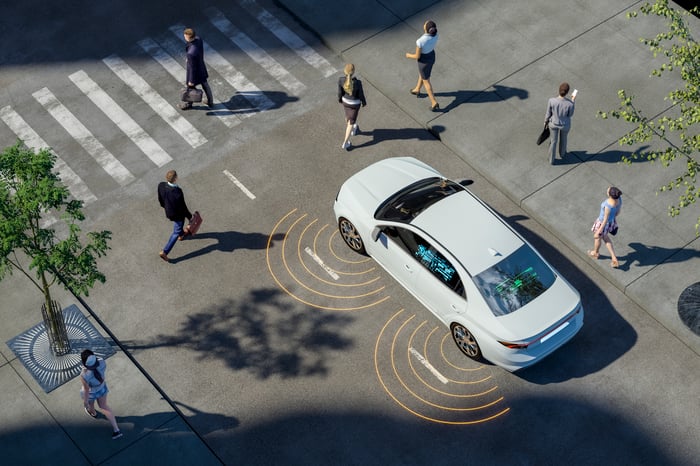Tesla (TSLA 1.85%) has been selling electric vehicles (EVs) at scale for more than a decade, and it has since been the industry leader by a wide margin. In 2014, the company revealed plans to introduce driver assistance software that would eventually be capable of piloting each Tesla vehicle without human input.
Today, that technology is known as full self-driving (or autonomous driving), and it's currently available in beta mode for some Tesla customers.
Missed timelines aside, CEO Elon Musk has spoken about the enormous opportunities self-driving will create for Tesla and its customers. But in a June 6 Twitter post, he said he'd also be willing to license the software to other car makers. It's a move that could rake in billions of dollars at a very high profit margin, so let's explore the details.

Image source: Getty Images.
Full self-driving might be around the corner
According to Cathie Wood's Ark Investment Management, Tesla currently has 2.7 million vehicles on the road testing the beta version of its full self-driving software. In the first quarter of 2023, those customers reached an important milestone: The number of total miles they've driven using the autonomous technology crossed 150 million. It means Tesla has more data than any of its competitors, and data is king for any software that relies on artificial intelligence (AI) to learn and improve.
Musk has a grand vision for the way full self-driving will work in the real world. In his eyes, it isn't a novelty that customers will use to get from point-to-point more conveniently, but rather it will transform mobility in general.
In a sit-down interview with CNBC's David Faber following Tesla's annual shareholder meeting in May, he said the average passenger vehicle was only used for an average of 10 to 12 hours per week, spending the majority of its time parked at the owner's home or workplace. By installing self-driving software, that idle time can be spent on the road serving in a ride-hailing network, earning money for both the owner and for Tesla.
In that same interview, Musk said he believed the company's full self-driving software could be publicly released later this year.
Full self-driving is a substantial financial opportunity
Tesla has the highest gross profit margin of all car manufacturers. It came in at 19.3% in Q1, and that was after the company slashed the price of its vehicles to drive demand in this weak economic environment.
But self-driving software is a game-changer because it can be developed once and sold an infinite number of times. The typical software company operates at a gross profit margin of 70% (or more), and Musk said Tesla could theoretically sell its vehicles at cost price and rely on customers installing its autonomous technology as its main source of profit.
Operating an autonomous ride-hailing network would take that a step further. Musk says Tesla could split ride-sharing revenue with its customers 50/50 or 70/30, which means it will earn money from each vehicle sold for as long as it's on the road! But how much revenue might be on the table? Ark Investment Management thinks autonomous ride-sharing platforms could generate as much as $4 trillion by 2027, which could make this Tesla's largest opportunity ever.
Here's how much licensing autonomous software could be worth to Tesla
Without knowing the precise economics, like what Tesla would charge other car makers for its full self-driving software, or what they'd be willing to pay, it's hard to know how big this opportunity could be. However, there's already one company setting some benchmarks: Nvidia (NVDA 3.65%).
Nvidia is one of the world's best semiconductor producers, and it's also the undisputed leader in artificial intelligence technologies right now. It also has a booming automotive segment which often gets overlooked by investors because it's only generating a small amount of revenue at the moment. However, its Drive platform is a complete hardware and software solution for any automotive manufacturer looking to install self-driving capabilities into its new cars.
So far, Nvidia has signed up dozens of leading car brands, with Mercedes Benz set to launch a new car with the platform installed in 2024. To date, those customers have signed $14 billion worth of deals with Nvidia which will convert to revenue between now and 2028.
That's a great sign for Tesla because it proves there is clear demand from third parties, and they have an appetite to invest billions of dollars in self-driving software. But will Tesla actually pursue this opportunity? Elon Musk's Twitter post aside, the company just agreed to grant Ford's (F 0.47%) EV customers access to its charging network nationwide, so it's certainly taking a more open approach to its technology.
In the end, more revenue opportunities will almost always spell good news for investors.





